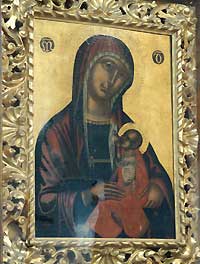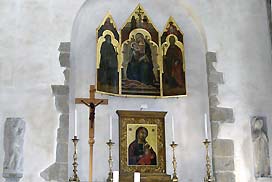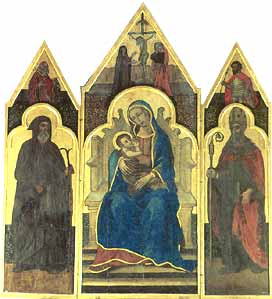|
 The
long and tapering hands of the Virgin, the red cloth wrapping up the baby and
the initials in Greek letters. The
long and tapering hands of the Virgin, the red cloth wrapping up the baby and
the initials in Greek letters. But
in this work, to the figures deprived of the classic Byzantine
figurative tradition, is used such light to give an unusual fullness
and density to faces and soft undulations to drapery. The iconographic
schemes are renewed by the diverse pictorial fashion which uses on the
faces colour with deep clashes and hard glitter, with full, solemn
figures laden with serene humanity and a masterly construction of the
drawing. The figure gains its pictorial density over the brilliant golden
background. The veil wraps the small face with the rhythmic drapery;
the beautiful and slender hands support the light, suckling baby
wrapped up in the thick dress’s weaving. In the extremely composite context of XII and XIII century Sicilian
culture this work assumes a particular importance as it documents the
vitality and the vivid presence of the Byzantine figurative canons in
the painting field, exactly during that artistic transition which
shall last till the Renaissance’ threshold in the local artists works.
 A triptych A triptych A triptych,
of the XIV century, painted on wood in Gothic
style, is placed on the major altar over the icon of Santa Maria. In the centre portrays the Vingin on the throne while
breast-feeding the Baby and on the side panels the fathers of
eastern and western monasticism; San Benedetto with cope
and pastoral mitre and rules book (to the right) and (to the left),
San Basilio in habit and pastoral a tau. Above, in the utmost centre there is Christ crucifixion, with the
Virgin and San Giovanni at the cross feet. In the lateral lunettes
you can see, on the left, a bishop with a Greek pontifical dress,
pastoral and book (San Nicola) and at right, a warrior with armour,
crossed shield and lance (San Giorgio or Guglielmo II). The figures on the panels stand out on the gilt background and appear
realistically human, even keeping their strong symbolic charge. Evident stylistic and constituent analogies suggest the hypothesis
that even the altar-piece placed on the left nave, depicting Santa
Lucia with her martyrdom’s attributes, and in the lunette the
archangel Gabriel, could belong to the polyptych of the high
altar.
Holy Lucia
The
altar-piece of pyramidal shape (XI
century), originally part of a composition of several sections
painted on board, represents Holy Lucia
with the attributes of her martyrdom and, in the triangular part, the archangel
Gabriel. The image of the Saint, defined above by a rich frame, stands up on the bottom made of brilliant gold. The erected figure, expressed by a bulky mantle which wraps it up down to the feet, takes body and strength in the well modeled human features of the
face. |